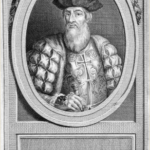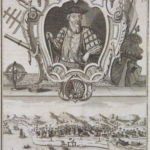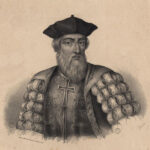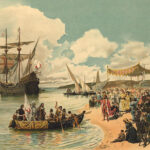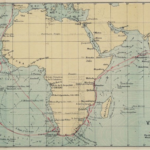Vasco da Gama
Explorer
Age of Discovery
Quick Facts:
Portuguese explorer and navigator who found a direct sea route from Europe to Asia, and was the first European to sail to India by going around Africa.
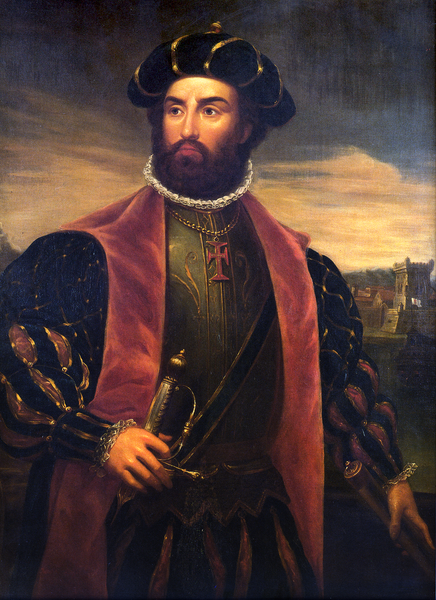
Vasco da Gama
Portrait of Vasco da Gama by artist Antonio Manuel da Fonseca in 1838. Vasco da Gama, (c.1469 – 1524) was a Portuguese explorer, one of the most successful in the European Age of Discovery and the commander of the first ships to sail directly from Europe to India. (Credit: National Maritime Museum)
Introduction
Vasco da Gama was a Portuguese explorer who sailed to India from Europe. Gold, spices, and other riches were valuable in Europe. But they had to navigate long ways over sea and land to reach them in Asia. Europeans during this time were looking to find a faster way to reach India by sailing around Africa. Da Gama accomplished the task. By doing so, he helped open a major trade route to Asia. Portugal celebrated his success, and his voyage launched a new era of discovery and world trade.
Biography
Early Life
Vasco da Gama’s exact birthdate and place is unknown. It is believed he was born between 1460 and 1469 in Sines, Portugal.1 He was the third son to his parents. His father, Estêvão da Gama, was a knight in the Duke of Viseu’s court; and his mother was a noblewoman named Isabel Sodré.2 His father’s role in the court would have allowed young Vasco to have a good education. But because he lived close to a seaport town, he probably also learned about ships and navigation. Vasco attended school in a larger village about 70 miles from Sines called Évora. Here, he learned advanced mathematics, and studied principles of navigation. By fifteen he became familiar with trading ships that were docked in port. By the age of twenty, he was the captain of a ship.3 These skills would all make him an acceptable choice to lead an expedition to India.
Vasco da Gama’s maritime career was during the period when Portugal was searching for a trade route around Africa to India. The Ottoman Empire controlled almost all European trade routes to Asia. This meant they could, and did, charge high prices for ships passing through ports. Prince Henry of Portugal – also called Prince Henry the Navigator – began Portugal’s great age of exploration. From about 1419 until his death in 1460, he sent several sailing expeditions down the coast of Africa.4 In 1481, King John II of Portugal began sending expeditions to find a sea route around the southern shores of Africa. Many explorers made several attempts. It was Bartolomeu Dias who was the first to round Africa and make it to the Indian Ocean in 1488. But he was forced to head back to Portugal before he could make it to India. When Manuel I became king of Portugal in 1495, he continued efforts to open a trade route to India by going around Africa. Although other people were considered for the job, Manuel I finally chose thirty-seven year old Vasco da Gama for this task.
Voyages
Principal Voyage
On 8 July 1497 Vasco da Gama sailed from Lisbon with a fleet of four ships with a crew of 170 men from Lisbon. Da Gama commanded the Sao Gabriel. Paulo da Gama – brother to Vasco – commanded the São Rafael, a three masted ship. There was also the caravel Berrio, and a storeship São Maria. Bartolomeu Dias also sailed with da Gama, and gave helpful advice for navigating down the African coast. They sailed past the Canary Islands, and reached the Cape Verde islands by July 26. They stayed about a week, then continued sailing on August 3. To help avoid the storms and strong currents near the Gulf of Guinea, da Gama and his fleet sailed out into the South Atlantic and swung down to the Cape of Good Hope. Storms still delayed them for a while. They rounded the cape on November 22 and three days later anchored at Mossel Bay, South Africa.5 They began sailing again on December 8. They anchored for a bit in January near Mozambique at the Rio do Cobre (Copper River) and continued on until they reached the Rio dos Bons Sinais (River of Good Omens). Here they erected a statue in the name of Portugal.
They stayed here for a month because much of the crew were sick from scurvy – a disease caused by lack of Vitamin C.6 Da Gama’s fleet eventually began sailing again. On March 2 they reached the Island of Mozambique. After trading with the local Muslim merchants, da Gama sailed on once more stopping briefly in Malindi (in present day Kenya). He hired a pilot to help him navigate through the Indian Ocean. They sailed for 23 days, and on May 20, 1498 they reached India.7 They headed for Kappad, India near the large city of Calicut. In Calicut, da Gama met with the king. But the king of Calicut was not impressed with da Gama, and the gifts he brought as offering. They spent several months trading in India, and studying their customs. They left India at the end of August. He visited the Anjidiv Island near Goa, and then once more stopped in Malindi in January 1499. Many of his crew were dying of scurvy. He had the São Rafael burned to help contain the illness. Da Gama finally returned to Portugal in September 1499. Manuel I praised da Gama’s success, and gave him money and a new title of admiral.
Subsequent Voyages
Vasco da Gama’s later voyages were less friendly with the people he met. He sailed once again beginning in February 1502 with a fleet of 10 ships. They stopped at the Cape Verdes Islands, Mozambique, and then sailed to Kilwa (in modern day Tanzania). Da Gama threatened their leader, and forced him and his people to swear loyalty to the king of Portugal. At Calicut, he bombarded the port, and caused the death of several Muslim traders. Again, later at Cochin, they fought with Arab ships, and sent them into flight.8 Da Gama was paving the way for an expanded Portuguese empire. This came at the cruel treatment of East African and South Asian people. Finally, on February 20, 1503 da Gama began the return journey home arriving on October 11 1503. King Manuel I died in 1521, and King John III became ruler. He made da Gama a Portuguese viceroy in India.9 King John III sent da Gama to India to stop the corruption and settle administrative problems of the Portuguese officials. Da Gama’s third journey would be his last.
Later Years and Death
After he had returned from his first trip, in 1500 Vasco da Gama had married Caterina de Ataíde. They had six sons, and lived in the town Évora. Da Gama continued advising on Indian affairs until he was sent overseas again in 1524. Vasco da Gama left Portugal for India, and arrived at Goa in September 1524. Da Gama quickly re-established order among the Portuguese leaders. By the end of the year he fell ill. Vasco da Gama died on December 24, 1524 in Cochin, India. He was buried in the local church. In 1539, his remains were brought back to Portugal.
Legacy
Vasco De Gama was the first European to find an ocean trading route to India. He accomplished what many explorers before him could not do. His discovery of this sea route helped the Portuguese establish a long-lasting colonial empire in Asia and Africa. The new ocean route around Africa allowed Portuguese sailors to avoid the Arab trading hold in the Mediterranean and Middle East. Better access to the Indian spice routes boosted Portugal’s economy. Vasco da Gama opened a new world of riches by opening up an Indian Ocean route. His voyage and explorations helped change the world for Europeans.
Images
- Portrait of Vasco da Gama by artist Antonio Manuel da Fonseca in 1838. Vasco da Gama, (c.1469 – 1524) was a Portuguese explorer, one of the most successful in the European Age of Discovery and the commander of the first ships to sail directly from Europe to India. (Credit: National Maritime Museum)
- “D. Vasco de Gama,” Histoire de la Conquete de La Floride: ou Relation de Ce Qui S’est Passé Dans La D’ecouverte de Païs Par Ferdinand de Soto; Composee en Espagnol Par L’Inca Garcillasso de la Vega & Traduite en François Par Sr. Pierre Richelet, 1735, From The Library at The Mariners’ Museum, E123.C5 rare.
- “Vasco de Gama,” Histoire des Déouvertes et Conquestes des Portugais dans le Nouveau Monde: Avec des Figures en Taille-Douce, 1733-34, From The Library at The Mariners’ Museum, DP583.L16 rare.
- Portuguese navigator and explorer, Vasco da Gama By Charles Legrand. {{PD-Art}}
- Vasco da Gama in India in 1497 By Alfredo Roque Gameiro (1864-1935). (Credit: National Library of Portugal)
- “A Chart Illustrating the First Voyage of Vasco Da Gama, 1497-1499,” A journal of the First Voyage of Vasco da Gama, 1497-1499, 1898, From The Library at The Mariners’ Museum, G401.G2.V45.1898.
Endnotes
- Emmanuel Akyeampong and Henry Louis Gates, Dictionary of African Biography (Oxford : Oxford University Press, 2012), 415.
- Akyeampong and Gates, Dictionary of African Biography, 415.
- Patricia Calvert, Vasco Da Gama: So Strong a Spirit (Tarrytown: Benchmark Books, 2005), 11-12.
- Aileen Gallagher, Prince Henry, the Navigator: Pioneer of Modern Exploration (New York: The Rosen Publishing Group, Inc., 2003), 5.
- Kenneth Pletcher, ed., The Britannica Guide to Explorers and Explorations That Changed the Modern World (New York: The Rosen Publishing Group, 2009), 54.
- Pletcher, The Britannica Guide, 55.
- Pletcher, The Britannica Guide, 55.
- Pletcher, The Britannica Guide, 57.
- Pletcher, The Britannica Guide, 58.


